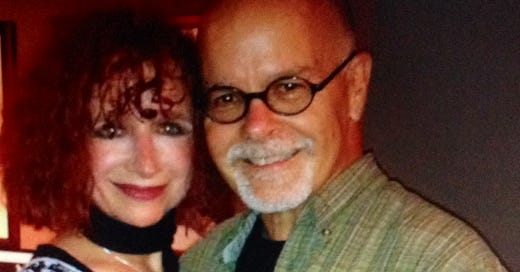Sandra and I have been dancing Tango since we met, and the socializing that comes along with dancing has been at the center of our life together. Last night we danced until midnight at our favorite dance studio, Four Seasons, in an ally across Loring Park from the apartment I no longer live in. It’s a high-ceilinged warehouse space with lots of ridiculously comfortable funky sofas and chairs just off the dance floor. Art on the walls. Hanging plants. One wall of mirrors. A kitchen counter where people place the bottles of wine and snacks they bring to share. Brie and crackers. Empanadas. Trays of cut watermelon and pineapple, baloney and cheese.
We are as mixed a crowd as can be found between Chicago and the Northwest Coast. Our dance partners come from places as diverse as Bulgaria and Japan, Argentina and England, even Egypt. Some of us grew up on farms and in small towns, some in the burbs, others, like Sandra, were city kids. One woman I like to dance with landed up here from Kenya, via Montreal, another from Colombia. We are doctors and lawyers, teachers and architects, engineers and editors. Gay and straight. God only knows what some of us think of politics.
Friends have come and gone, some dying or moving away, others still in the room but no longer friends. We speak of the “dance community,” and community, as the Quaker philosopher Parker Palmer has said, is “where the person you least want to see is.” That means that in community we have history. The human condition being what it is, some of that history is bound to be complicated. The difficult skill of learning to navigate that space has been a good thing in my life.
Last night, dancing with a friend, we started talking about this Substack and my Loring posts. I told her my post last week was my last on that subject. I would have to find something else to write about for my Wednesday musings. Loring was finished. When I got home and went upstairs to hang up my clothing and jump into my PJs, I thought, yeah, I’ve said all I had to say about Loring—but then stopped. Had I? It suddenly felt as if I’d I left a lot unsaid.
It struck me that I had outlined how hard I had worked on my trade as a teacher and writer, but that somehow I hadn’t said all I had done or given myself the credit I should have. This may seem overly self-involved and maybe it is. Maybe it’s an embarrassing reflection of my insecurity, but in fact I hadn’t mentioned the two anthologies of children’s writing I had put together and edited, nor had I written a word about the race car book for kids I’d written or the gallery book I’d ghost written for a critic in Chicago. I hadn’t mentioned the speeches I’d given to banquets or literacy councils or teacher in-services. No, and I hadn’t gone into that preschool storytelling gig I invented—“Johnny Appleseed and How Things Grow.” I showed up in bib overalls with a set that included a paper mache sun and a rain cloud I’d made, both with whimsically painted faces. The cloud had strips of blue Oxford cloth as rain that I tickled the children with. They pretended to be seeds growing into trees in a creative drama game I led them through. For my opening, I juggled apples. Badly. The badly was part of my schtick. There’s nothing in the world like getting a crowd of four-year-olds laughing.
Maybe it’s all just as well that I left those things out. But some day, maybe, my granddaughters will be reading this, and I want them to know that their Grandad wasn’t just hanging around his little apartment all those years getting drunk on his private supply of red wine and wrestling with his demons.
I want them—and you—to know what I keep seeing come around a couple times a year on my Facebook page. It’s a photo of an outrageously, “inappropriately” dressed old woman with the caption that goes something like, “The older I get the more I realize that it’s okay to live a life that nobody else understands.”
All of this has been an attempt to better understand my own growth living in Loring Park. In that time, I acknowledged my calling to teach and write, I fell in love for real, was blessed to eventually give up my over-indulgence in wine, returned to writing short stories with no particular ambition to be widely known, and managed to wrestle my demons to a standstill for at least the moment. I credit Sandra and the dance community for being, in that order, the agent and the context by which most of that happened.
When we dance, we follow line-of-dance, a counter-clockwise movement to avoid collision and sloppy entanglements. We create lanes so that there might be two or three circles on a crowded dance floor. We make eye contact to create space for entering couples. We learn how to avoid smashing into other couples, even the ones who take up too much space and don’t watch out for others. We even extend this consideration to people we don’t much like, people we have unpleasant or complicated history with. And we follow the music, matching its emotion with our bodies within the boundaries of the dance. We express our joy and, often, our pain. Life changes. Happiness appears or evaporates. Pain often lingers like an odor. It’s good to remember all that, and to keep trying to connect mindfully and move to the music.
Has everything been said about Loring?
No. Never. But it’s time to move on now.



